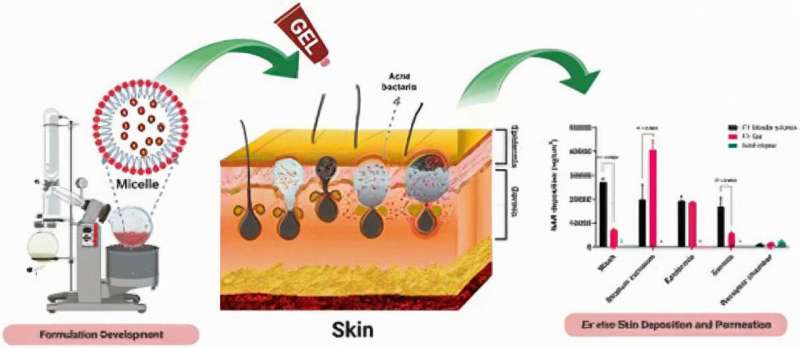
It’s a skin disorder that makes life miserable for around 800 million teenagers and adults worldwide, but Australian scientists may have found an effective treatment for acne, delivered via tiny nanoparticles.
In a study led by the University of South Australia (UniSA), a new antibacterial compound known as Narasin was encased in tiny, soft nanoparticles 1,000 times smaller than a single strand of human hair and applied in a gel form to targeted acne sites.
The drug—more commonly used in the livestock industry—proved successful against drug-resistant acne bacteria and delivered via nanocarriers achieved a 100-fold increase in absorption than simply taken with water.
The findings have been published in the journal Nanoscale.
Lead author UniSA Ph.D. student Fatima Abid says this is the first time that nano-micelle formulations of Narasin have been developed and trialed.
“Acne severely impacts approximately 9.4% of the world’s population, mainly adolescents, and causes distress, embarrassment, anxiety, low self-confidence and social isolation among sufferers,” Abid says.
“Although there are many oral medications prescribed for acne, they have a range of detrimental side effects, and many are poorly water soluble, which is why most patients and clinicians prefer topical treatments.”
Abid’s supervisor, pharmaceutical scientist Professor Sanjay Garg, says a combination of increasing antibiotic resistance and the ineffectiveness of many topical drugs to penetrate hair follicles in acne sites means there is a pressing need to develop new antibacterial therapies that are effective and safe.
Narasin is commonly used for bacterial infections in livestock but has never been previously investigated as a viable treatment for acne.
Abid, Prof. Garg and researchers from UniSA, the University of Adelaide, and Aix-Marseille Université in France also investigated how well Narasin encased in nanoparticles penetrated various layers of skin, using pig’s ear skin as a model.
“The micelle formulation was effective in delivering Narasin to acne targets sites, as opposed to the compound solution which failed to permeate through skin layers,” Prof. Garg says.
More information:
Fatima Abid et al, Nanotechnology and narasin: a powerful combination against acne, Nanoscale (2023). DOI: 10.1039/D3NR01789C
Journal information:Nanoscale
Provided by
University of South Australia

READ MORE
Don’t Be Afraid of the Big, Bad Wolf Spider
Female wolf spiders carry their egg sacs around with them to protect the unborn babies [...]
Busy Bees Take a Break During Total Solar Eclipses
A study conducted during the 2017 total solar eclipse in North America found that bees [...]
Growing metallic crystals in liquid metal
Experimental set up. Credit: FLEET Imagine an alien world with oceans of liquid metal. googletag.cmd.push(function() [...]
Should you use a coupon clipping service?
It’s true that clicking for coupons is a lot easier than clipping them, but coupon [...]
The World Told Through the Eyes of the Ginkgo Tree
The ginkgo biloba or Maidenhair tree has been around for at least 270 million years, [...]
New production process for therapeutic nanovesicles
The extracellular vesicles (red) produced using the new technique are absorbed in vitro by immune [...]
DNA nanotube rings: Research team develops important building block for artificial cells
StarPEG-(KA7)4 bundles DNA nanotubes. a Schematic illustration of DNA nanotubes formed from double-crossover DNA tiles. [...]
Twin photons from different quantum dots
Although the quantum dots of the Basel researchers are different, they emit exactly identical light [...]